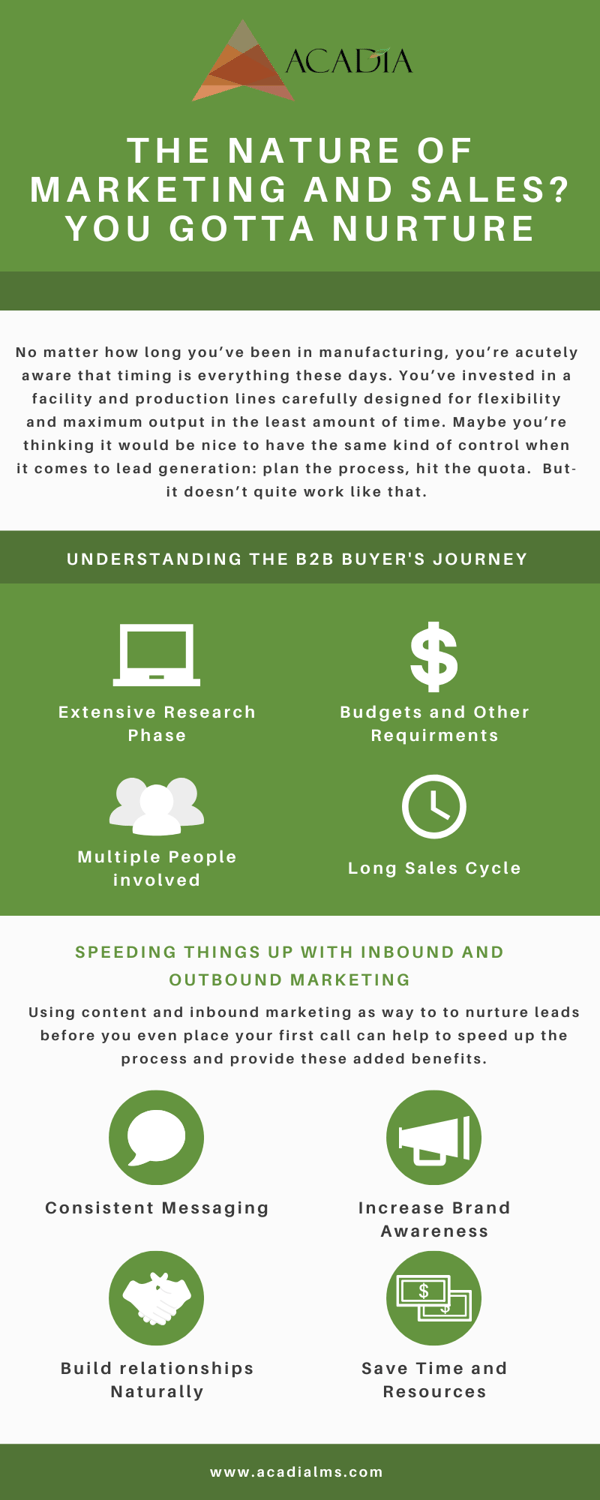Time and Timing in Lead Generation Part 1: You Gotta Nurture

No matter how long you’ve been in manufacturing, you’re acutely aware that timing is everything these days. You’ve invested in a facility and production lines carefully designed for flexibility and maximum output in the least amount of time. Maybe you’re thinking it would be nice to have the same kind of control when it comes to lead generation: plan the process, hit the quota. But- it doesn’t quite work like that.
Let’ face it- you don’t walk into a bar thinking you’ll come out begin engaged. But you may meet someone, and the journey begins! Relating this to business, most of your customers probably didn’t become customers the first time they heard of you or spoke with you. It takes time to identify them as prospects, get in touch with the right individual, nurture the relationship, and educate them about how you can meet their manufacturing need. Sometimes you’ll wait longer for them to even have a need for your work.
You have to develop trust and remain relevant and that means you need to deploy lead generation best practices, and everything that goes along with gaining new customers. It takes time, and your job is to remain timely by employing a combination of outbound and inbound methods for nurturing. And a little help from email and task automation can really help.
It’s pretty rare to just pick up the phone and get a lead. Before a call is even placed there’s background research, identifying the right person to call, and probably a few attempts before actually connecting with them. Only then can you ask questions, listen and respond, listen some more, and with luck, secure a Marketing Qualified Lead (an MQL) or a second phone appointment. Then it begins again with more questions, listening, and maybe making an offer. The process could take weeks or months if you’re staying on top of nurturing and regular check-ins. If you’re not it takes even longer, or the opportunity could be lost entirely.
The long sales cycle typical to the B2B world adds another layer of time. Purchasing committees, RFPs and bidding, design reviews, procurement procedures, budget allocations, and approvals all take time. You probably deal with this in your own efforts to purchase equipment and raw materials and your prospects are no different.
Interestingly, we don’t tend to think about nurturing until we’ve made contact. But what if you looked at the content and inbound marketing as a way to nurture leads before you even place that first call? That might speed things up a bit.
If your company is at least familiar to a prospect, you’ve got an inroad once you make contact. This kind of “pre-nurturing” can be as simple as finding your website in a search or reading your latest company Tweet. As an analogy, when you’re at a party, it’s far easier to connect with someone if you’ve heard about them from a mutual acquaintance. Hearing or saying, “Steve’s told me so much about you!” is a natural ice breaker. The same holds true in manufacturing. If a prospect can say they’ve seen your website or got an email from you, there’s a common ground for a conversation when you get them on the phone.
We often think of inbound and outbound marketing as opposite ends of a spectrum. Traditionally outbound means cold calling, inbound means content, usually on a website or social media platform. These two don’t often mix, and sometimes the messaging doesn’t even match.
But if you align the two as tools for nurturing, you’re more likely to have consistent messaging. Your blog, white papers, ebooks, and social media should reflect what you talk about with prospects and customers. Your phone conversations should include a couple of well-timed references to your content. For example, have you just created a series of videos that highlight your automated work cell or your ability to deburr stamped parts with a new machine? Do you have a cool new ebook with powerful infographics? Reps need to be sharing this content too, not just your website or social media.
What’s more, because you’re using both outbound and inbound methods to share your message, prospects can find you independently online, talk with you via phone or email, and continue to interact with you on the web or social media if they need more information later.
This approach is a little more work upfront because it means aligning talking points to content and vice versa. You’ll probably also have to develop additional content to target buyer personas and their pain points. But because you’ll always be nurturing, it can also mean better results in less time. Intrigued? Drop us an email or check back for part 2 of this series for an in-depth examination of what causes time lag in exclusively outbound campaigns (and some tips on what to do about it).

Comments